Performance Enhancement of Second-Life Lithium-Ion Batteries Based on Gaussian Mixture Model Clustering and Simulation-Based Evaluation for Energy Storage System Applications
Abstract
1. Introduction
2. Data Description and Pre-Processing
3. Clustering Methods
3.1. Support Vector Clustering (SVC)
3.2. K-Means
3.3. Gaussian Mixture Model (GMM)
3.3.1. Expectation Step
3.3.2. Maximization Step
4. Comparative Analysis
4.1. Clustering Methods Evaluation
4.2. Clustering Performance Evaluation
- The standard deviation of the final charging voltages measured across all 15 cells within the battery module, which indicates the degree of voltage imbalance among the cells at the end of the charging process.
- The average charge throughput of the 15 cells during the charging process, representing the total amount of charge each cell accepted on average, used as a measure of the overall charging performance and uniformity within the module.
- The difference between the maximum and minimum cell capacities within each cluster reflects the internal consistency of the clustering method in grouping cells with similar energy storage capabilities.
- The Coulombic efficiency of the battery module, calculated as the ratio of discharge capacity to charge capacity, used to evaluate how effectively the input electrical energy is converted into usable output energy.
5. Conclusions
Author Contributions
Funding
Institutional Review Board Statement
Informed Consent Statement
Data Availability Statement
Conflicts of Interest
References
- Xu, J.; Cai, X.; Cai, S.; Shao, Y.; Hu, C.; Lu, S.; Ding, S. High-energy lithium-ion batteries: Recent progress and a promising future in applications. Energy Environ. Mater. 2023, 6, e12450. [Google Scholar] [CrossRef]
- Ramoni; Olalekan, M.; Zhang, H.-C. End-of-life (EOL) issues and options for electric vehicle batteries. Clean Technol. Environ. Policy 2013, 15, 881–891. [Google Scholar] [CrossRef]
- Jena, A.; Borra, V.L.; Saida, S.; Venkatesan, P.; Önal, M.A.R.; Borra, C.R. Synergistic hydrometallurgical recycling of Li-ion battery cathode active material, anode copper and waste SmCo magnets. Sustain. Mater. Technol. 2025, 43, e01284. [Google Scholar] [CrossRef]
- Qiao, D.; Wang, G.; Gao, T.; Wen, B.; Dai, T. Potential impact of the end-of-life batteries recycling of electric vehicles on lithium demand in China: 2010–2050. Sci. Total Environ. 2021, 764, 142835. [Google Scholar] [CrossRef]
- Sarker, M.T.; Haram, M.H.S.M.; Shern, S.J.; Ramasamy, G.; Al Farid, F. Second-life electric vehicle batteries for home photovoltaic systems: Transforming energy storage and sustainability. Energies 2024, 17, 2345. [Google Scholar] [CrossRef]
- Mulleriyawage, U.G.; Shen, W. A review of battery energy storage systems for residential DC microgrids and their economical comparisons. DEStech Trans. Environ. Energy Earth Sci. 2019, 3, 1–26. [Google Scholar] [CrossRef]
- Ya, L.V. Energy Storage System (ESS) in Residential Applications. In Energy Storage Applications in Power Systems; IntechOpen: London, UK, 2023. [Google Scholar]
- Heymans, C.; Walker, S.B.; Young, S.B.; Fowler, M. Economic analysis of second use electric vehicle batteries for residential energy storage and load-levelling. Energy Policy 2014, 71, 22–30. [Google Scholar] [CrossRef]
- Duong, V.T.; Waheed, Z.; Choi, W. Non-Isolated Ultra-High Step-Up DC-DC Converter Topology Using Coupled-Inductor Based Inverting Buck-Boost and Voltage Multipliers. Preprints 2025, 2025052240. [Google Scholar] [CrossRef]
- Santos, D.; Fonte, P.M.; Pereira, R.; Barata, F.A.; Almeida, P.; Cordeiro, A.; Luís, R.; Pires, V. ESS Design and Management considering Solar PV to fed off-grid EV Charger. In Proceedings of the 2024 12th International Conference on Smart Grid (icSmartGrid), Setubal, Portugal, 27–29 May 2024; pp. 636–641. [Google Scholar] [CrossRef]
- Jeong, H.J.; Kwon, M.H.; Choi, S.W. A 48V-400V Non-isolated Bidirectional Soft-switching DC-DC Converter for Residential ESS. Trans. Korean Inst. Power Electron. 2018, 23, 190–198. [Google Scholar]
- Shahjalal, M.; Roy, P.K.; Shams, T.; Fly, A.; Chowdhury, J.I.; Ahmed, M.R.; Liu, K. A review on second life of Li-ion batteries: Prospects, challenges, and issues. Energy 2022, 241, 122881. [Google Scholar] [CrossRef]
- Li, W.; Chen, S.; Peng, X.; Xiao, M.; Gao, L.; Garg, A.; Bao, N. A comprehensive approach for the clustering of similar-performance cells for the design of a lithium-ion battery module for electric vehicles. Engineering 2019, 5, 795–802. [Google Scholar] [CrossRef]
- Jiang, Y.; Wang, Y.; Zhang, C.; Su, G.; Liu, J. Research on group methods of second-use Li-ion batteries based on k-means clustering model. In Proceedings of the 2014 IEEE Conference and Expo Transportation Electrification Asia-Pacific (ITEC Asia-Pacific), Beijing, China, 31 August–3 September 2014; pp. 1–6. [Google Scholar]
- Wu, S.; Chow, T.W. Clustering of the self-organizing map using a clustering validity index based on inter-cluster and intra-cluster density. Pattern Recognit. 2004, 37, 175–188. [Google Scholar] [CrossRef]
- He, X.; Cai, D.; Shao, Y.; Bao, H.; Han, J. Laplacian Regularized Gaussian Mixture Model for Data Clustering. IEEE Trans. Knowl. Data Eng. 2011, 23, 1406–1418. [Google Scholar] [CrossRef]
- Lai, X.; Deng, C.; Tang, X.; Gao, F.; Han, X.; Zheng, Y. Soft clustering of retired lithium-ion batteries for the secondary utilization using Gaussian mixture model based on electrochemical impedance spectroscopy. J. Clean. Prod. 2022, 339, 130786. [Google Scholar] [CrossRef]
- Severson, K.A.; Attia, P.M.; Jin, N.; Perkins, N.; Jiang, B.; Yang, Z.; Chen, M.H.; Aykol, M.; Herring, P.K.; Fraggedakis, D.; et al. Data-driven prediction of battery cycle life before capacity degradation. Nat. Energy 2019, 4, 383–391. [Google Scholar] [CrossRef]
- Li, C.; Wang, N.; Li, W.; Li, Y.; Zhang, J. Regrouping and Echelon Utilization of Retired Lithium-Ion Batteries Based on a Novel Support Vector Clustering Approach. IEEE Trans. Transp. Electrif. 2022, 8, 3648–3658. [Google Scholar] [CrossRef]
- Zhao, S.; Wu, F.; Yang, L.; Gao, L.; Burke, A.F. A measurement method for determination of dc internal resistance of batteries and supercapacitors. Electrochem. Commun. 2010, 12, 242–245. [Google Scholar] [CrossRef]
- How to Measure the Remaining Useful Life of a Battery. Battery University. Available online: https://batteryuniversity.com/article/bu-901b-how-to-measure-the-remaining-useful-life-of-a-battery (accessed on 17 March 2025).
- Dalatu, P.I.; Midi, H. New approaches to normalization techniques to enhance K-means clustering algorithm. Malays. J. Math. Sci. 2020, 14, 41–62. [Google Scholar]
- Yuan, C.; Yang, H. Research on K-Value Selection Method of K-Means Clustering Algorithm. J 2019, 2, 226–235. [Google Scholar] [CrossRef]
- Song, R.; Pang, F.; Jiang, H.; Zhu, H. A machine learning based method for constructing group profiles of university students. Heliyon 2024, 10, e29181. [Google Scholar] [CrossRef]
- Gaussian Mixture Model—Understanding and Implementation. Data Flair. Available online: https://data-flair.training/blogs/gaussian-mixture-model/ (accessed on 17 March 2025).
- Vassilvitskii, S.; Arthur, D. k-means++: The advantages of careful seeding. In Proceedings of the Eighteenth Annual ACM-SIAM Symposium on Discrete Algorithms, New Orleans, LA, USA, 7–9 January 2007; Society for Industrial and Applied Mathematics: Philadelphia, PA, USA, 2006; pp. 1027–1035. [Google Scholar]
- Zhang, T.; Kuo, C.C.J. Sound Effects Classification and Retrieval. In Content-Based Audio Classification and Retrieval for Audiovisual Data Parsing; The Springer International Series in Engineering and Computer Science; Springer: Boston, MA, USA, 2021; Volume 606. [Google Scholar] [CrossRef]
- Falah, N.; Falah, N.; Solis-Guzman, J.; Marrero, M. An Indicator-Based Framework of Circular Cities Focused on Sustainability Dimensions and Sustainable Development Goal 11 Obtained Using Machine Learning and Text Analytics. Sustain. Cities Soc. 2025, 121, 106219. [Google Scholar] [CrossRef]
- Sasithradevi, A.; Perumal, D.A.; Persiya, J. Infrared Perspectives: Computing laptop energy dissipation via thermal imaging and the Stefan-Boltzmann equation. Therm. Sci. Eng. Prog. 2024, 53, 102742. [Google Scholar] [CrossRef]
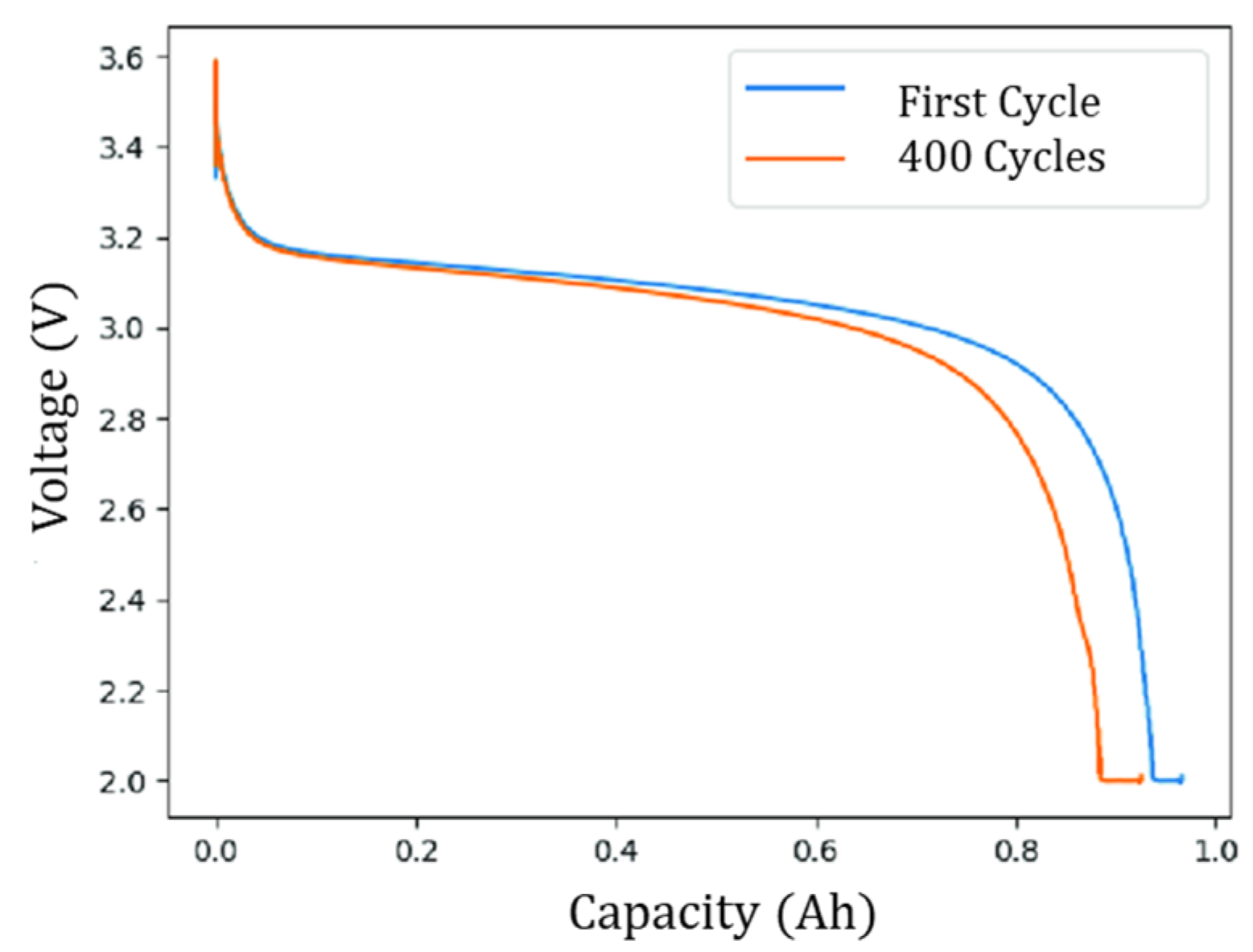
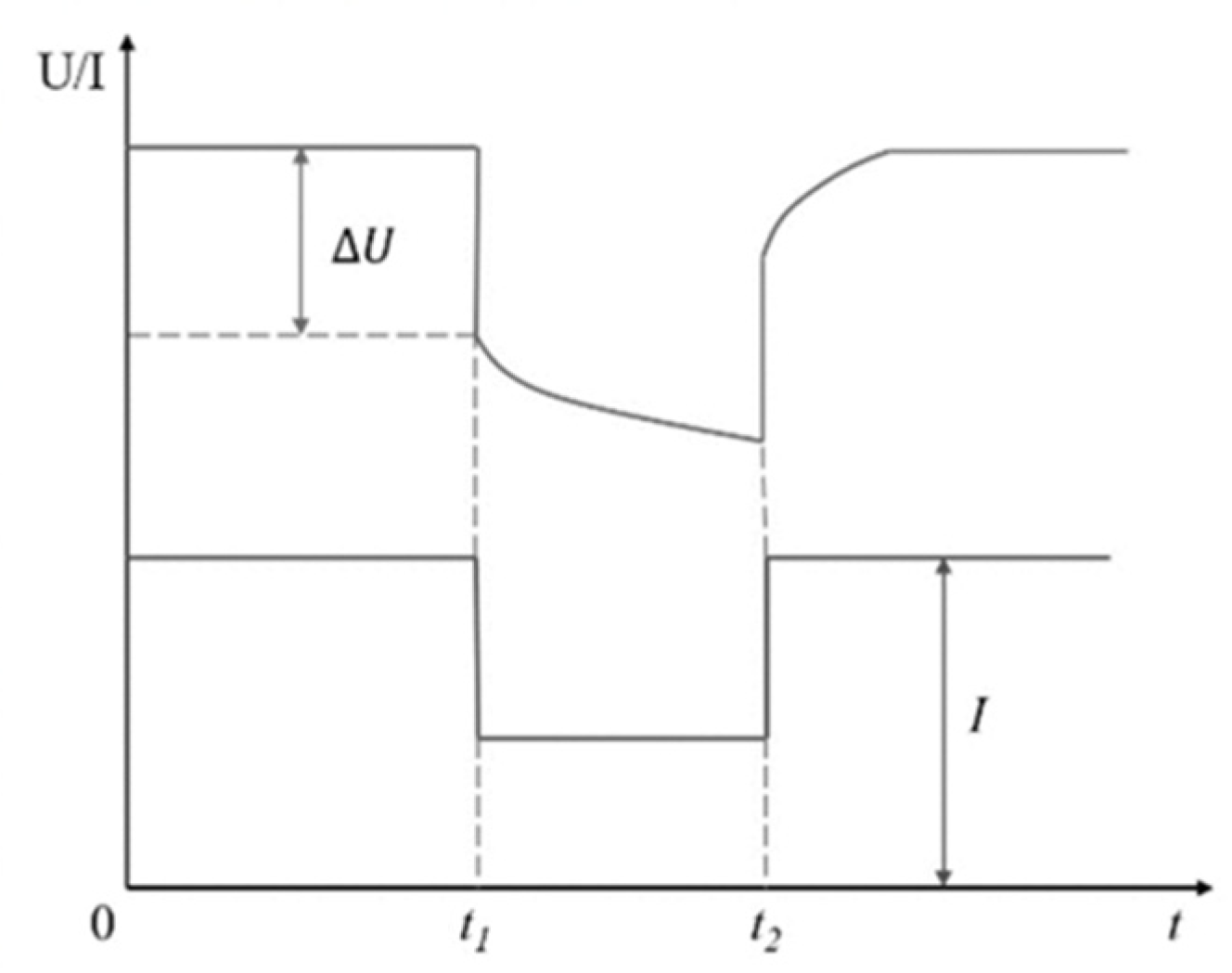


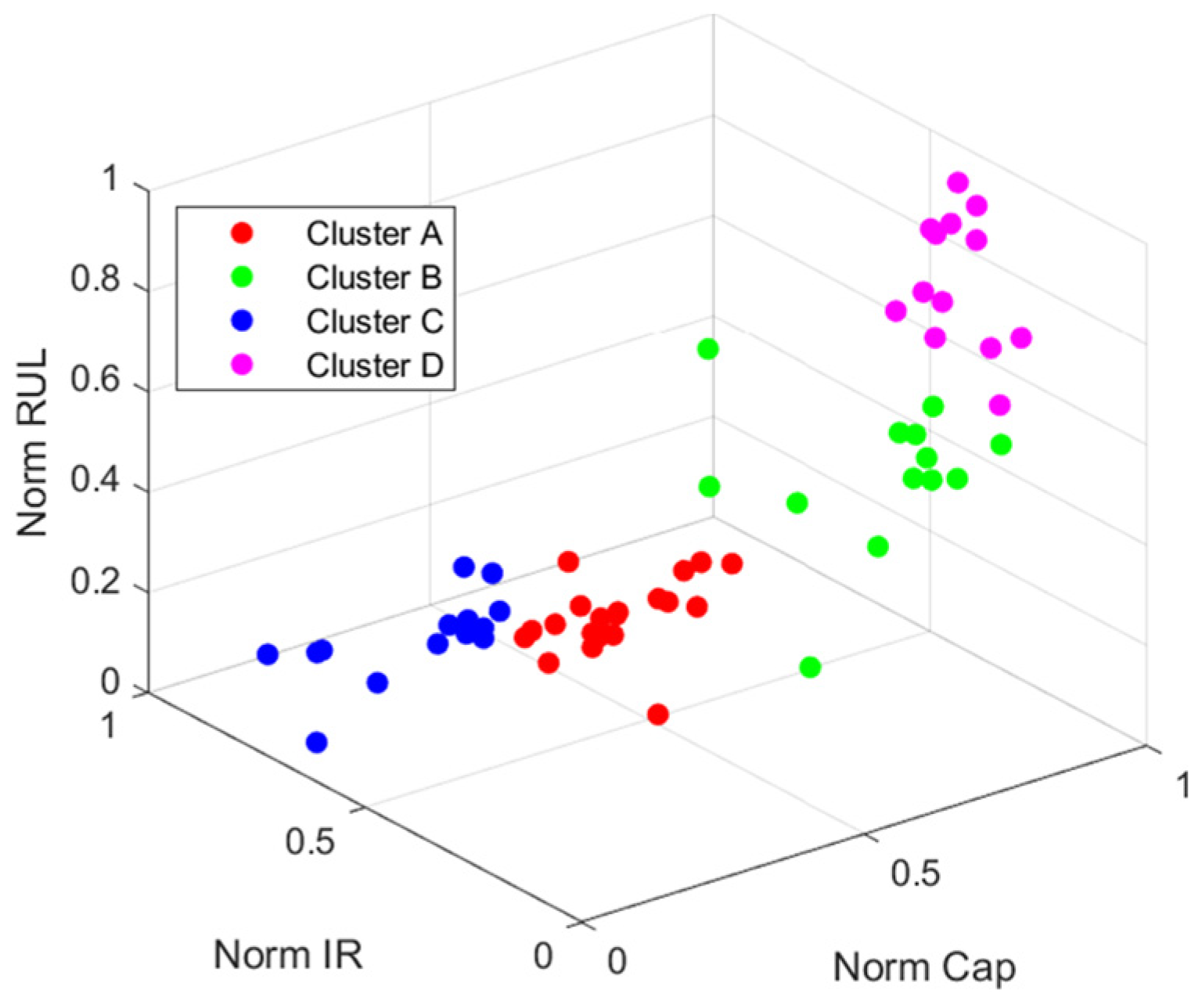
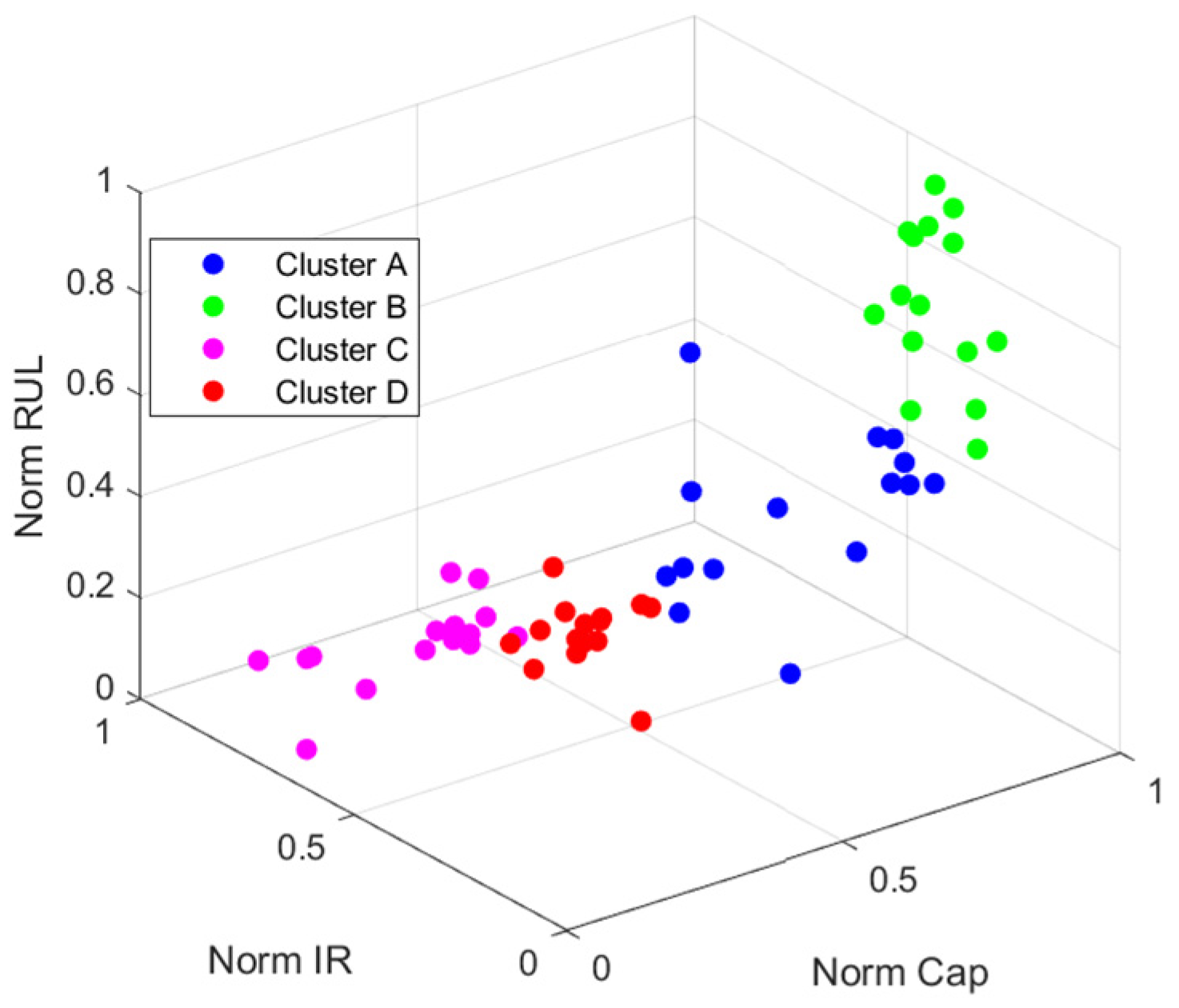

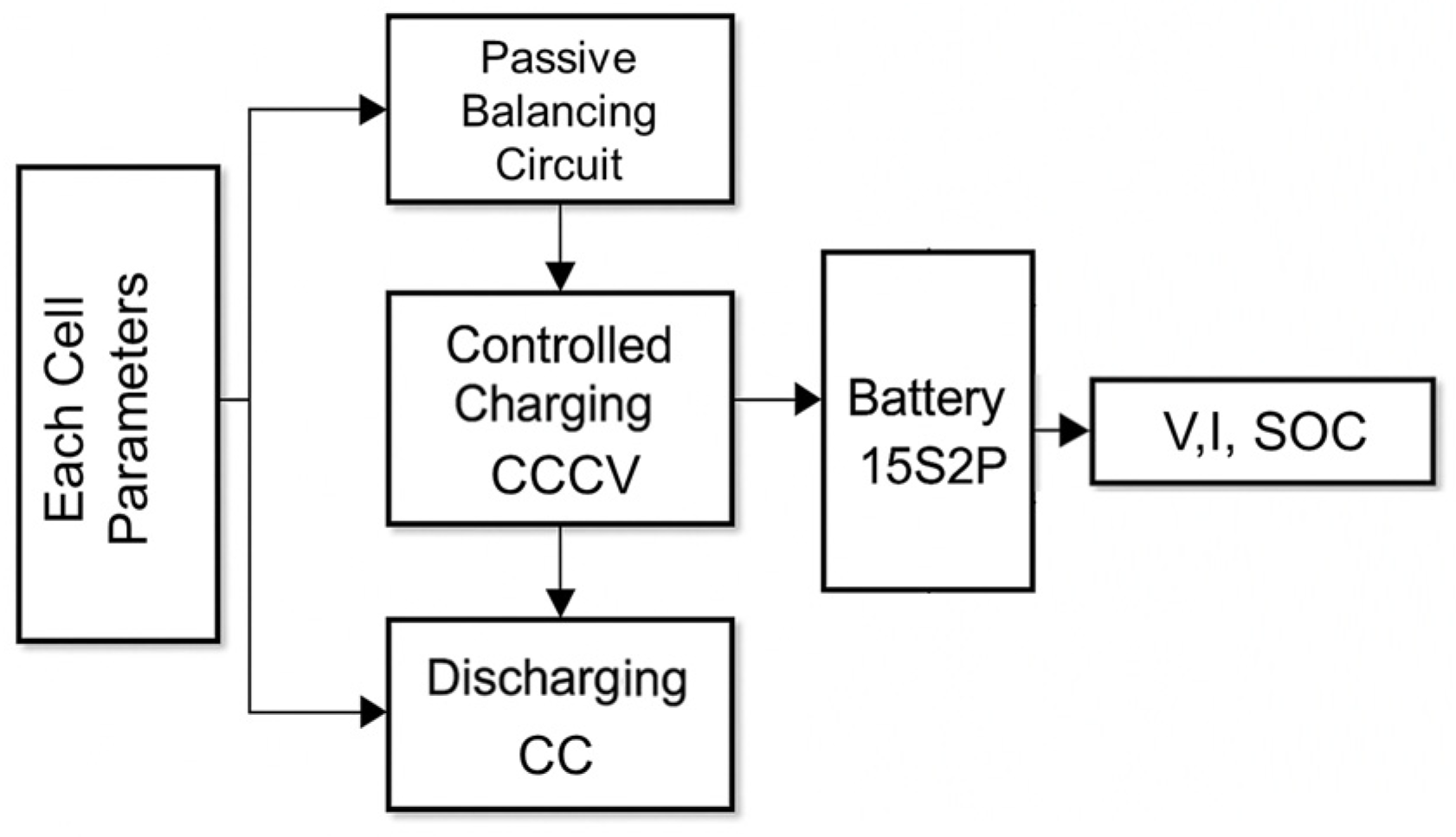
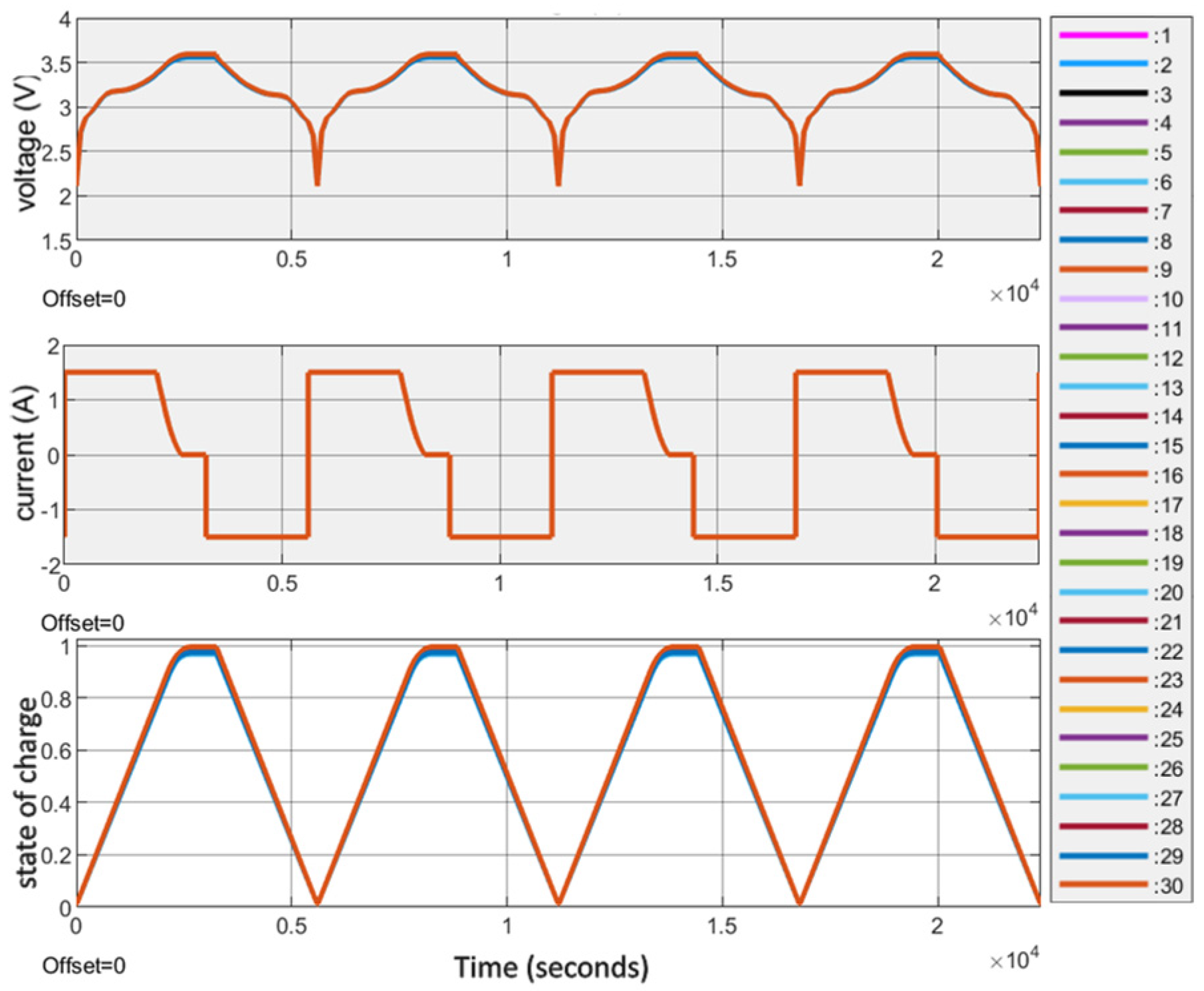
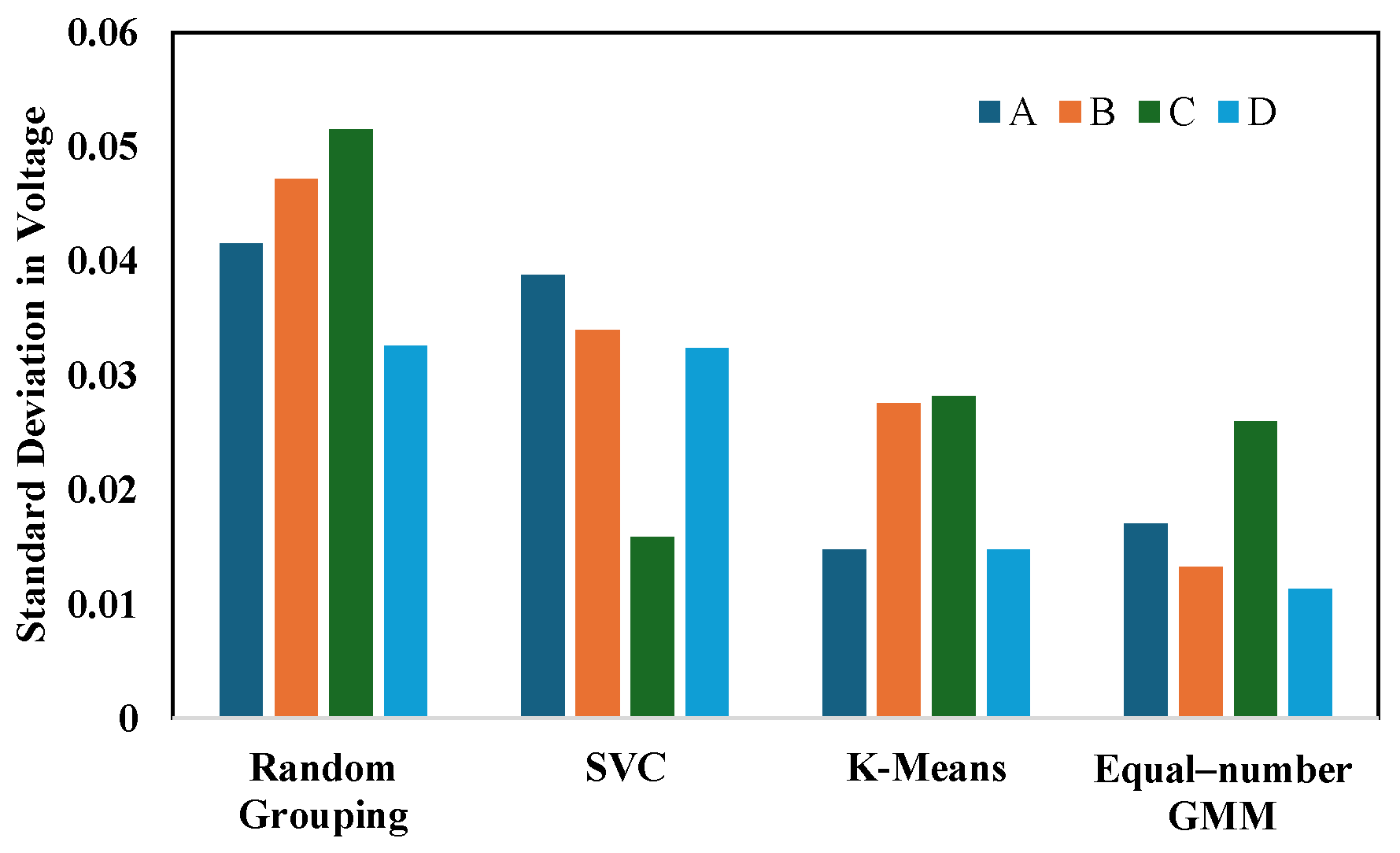
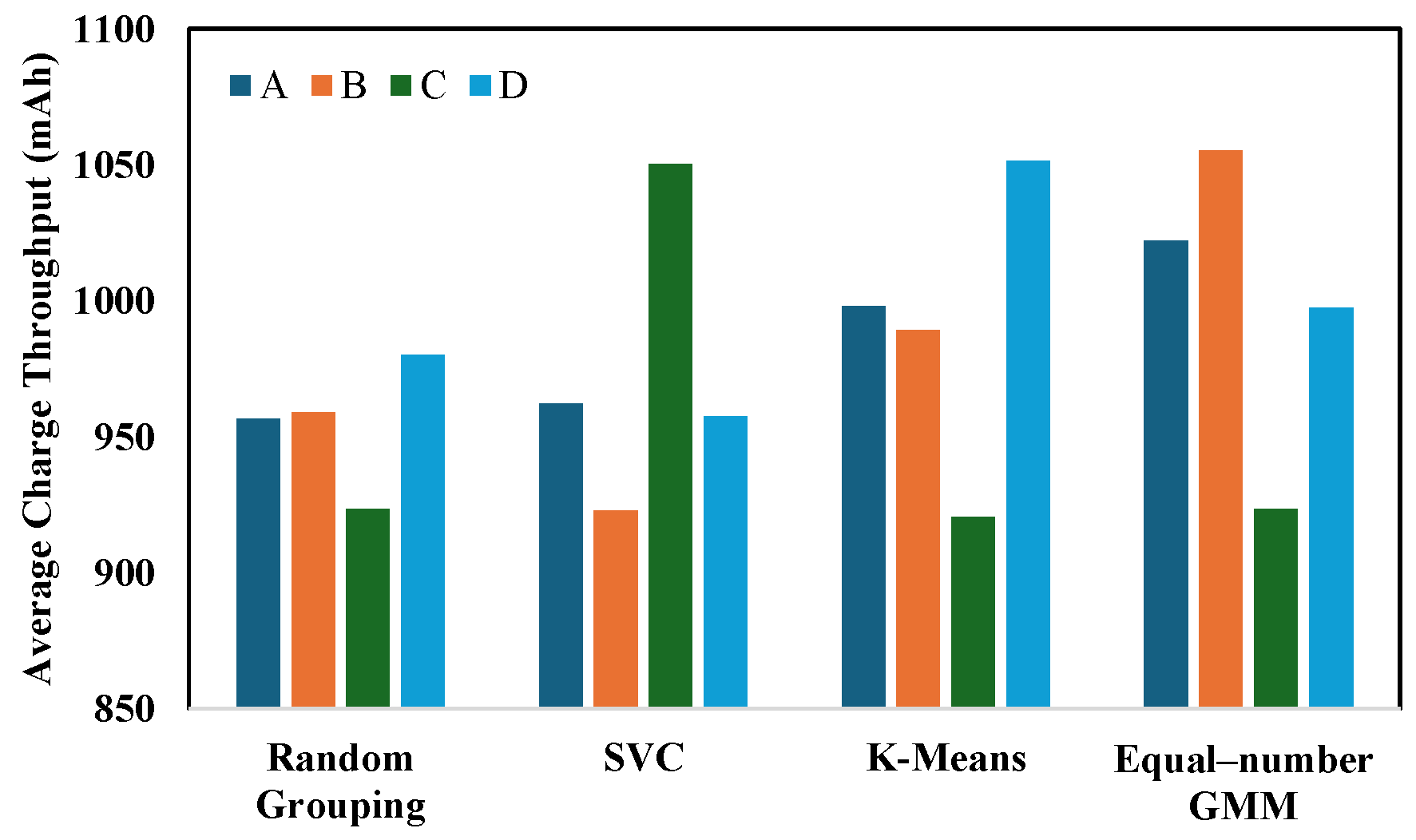
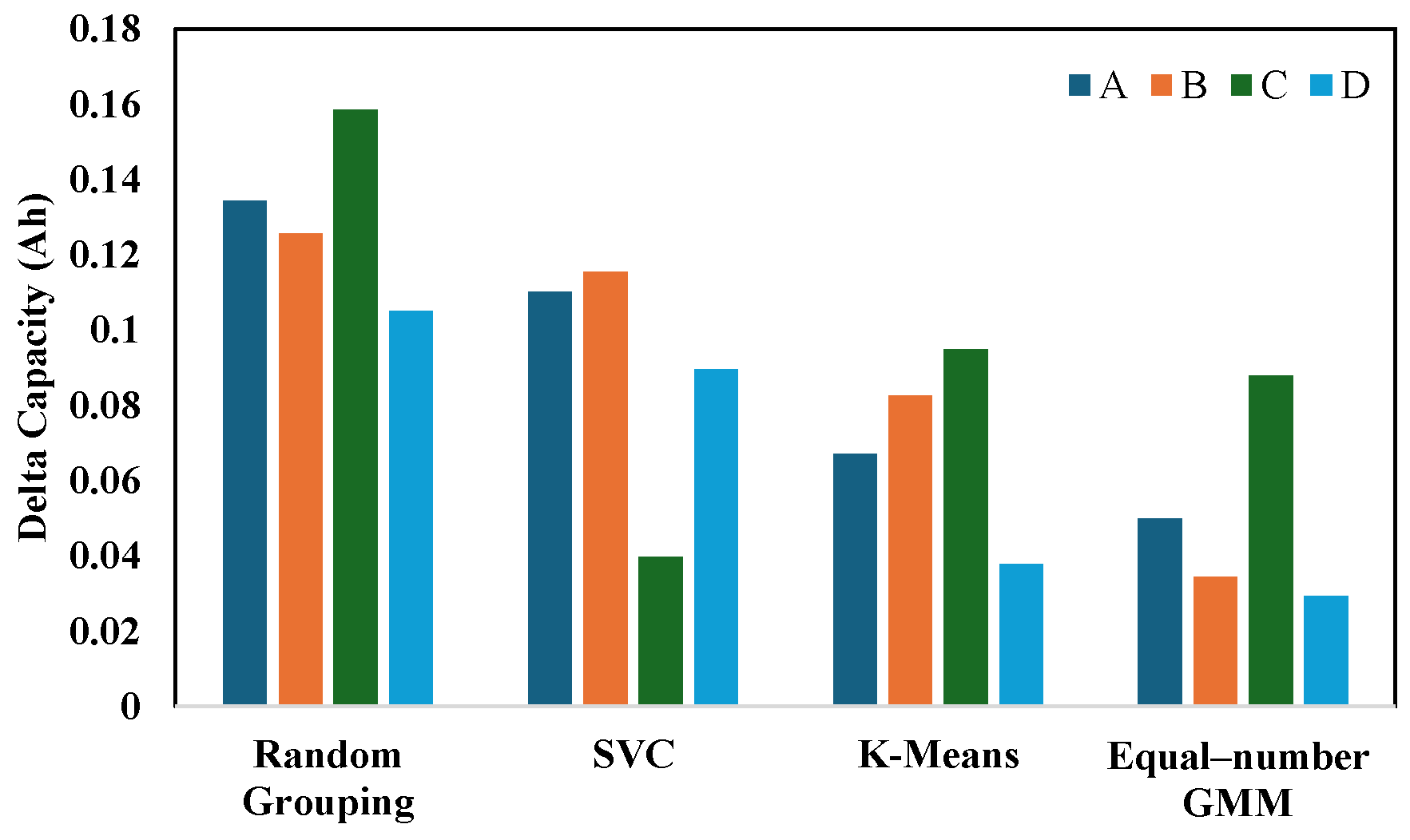

| Parameter | Value |
|---|---|
| Nominal Capacity | 1.1 Ah |
| Nominal Voltage | 3.3 V |
| Recommended standard charge method | 1.5 A to 3.6 V (CCCV) |
| Recommended charge and cut-off voltage at 25° | 3.6 to 2.0 V |
| Operating temperature range | −30~60 °C |
Disclaimer/Publisher’s Note: The statements, opinions and data contained in all publications are solely those of the individual author(s) and contributor(s) and not of MDPI and/or the editor(s). MDPI and/or the editor(s) disclaim responsibility for any injury to people or property resulting from any ideas, methods, instructions or products referred to in the content. |
© 2025 by the authors. Licensee MDPI, Basel, Switzerland. This article is an open access article distributed under the terms and conditions of the Creative Commons Attribution (CC BY) license (https://creativecommons.org/licenses/by/4.0/).
Share and Cite
Akram, A.S.; Choi, W. Performance Enhancement of Second-Life Lithium-Ion Batteries Based on Gaussian Mixture Model Clustering and Simulation-Based Evaluation for Energy Storage System Applications. Appl. Sci. 2025, 15, 6787. https://doi.org/10.3390/app15126787
Akram AS, Choi W. Performance Enhancement of Second-Life Lithium-Ion Batteries Based on Gaussian Mixture Model Clustering and Simulation-Based Evaluation for Energy Storage System Applications. Applied Sciences. 2025; 15(12):6787. https://doi.org/10.3390/app15126787
Chicago/Turabian StyleAkram, Abdul Shakoor, and Woojin Choi. 2025. "Performance Enhancement of Second-Life Lithium-Ion Batteries Based on Gaussian Mixture Model Clustering and Simulation-Based Evaluation for Energy Storage System Applications" Applied Sciences 15, no. 12: 6787. https://doi.org/10.3390/app15126787
APA StyleAkram, A. S., & Choi, W. (2025). Performance Enhancement of Second-Life Lithium-Ion Batteries Based on Gaussian Mixture Model Clustering and Simulation-Based Evaluation for Energy Storage System Applications. Applied Sciences, 15(12), 6787. https://doi.org/10.3390/app15126787







